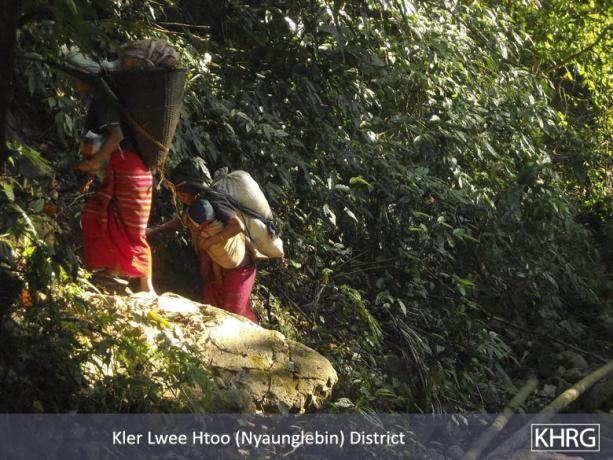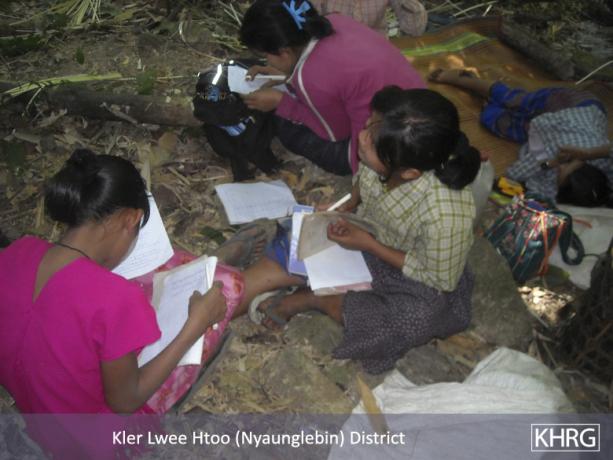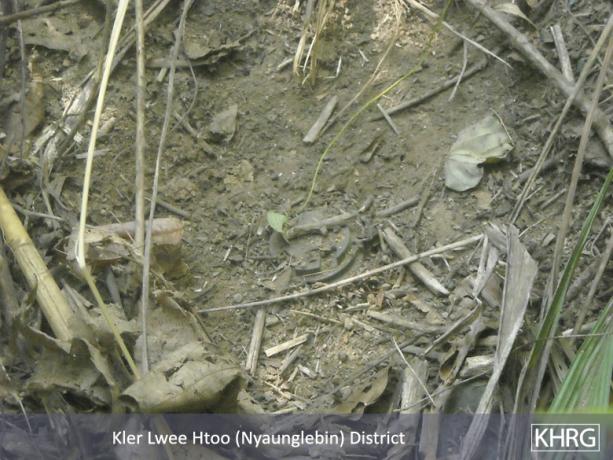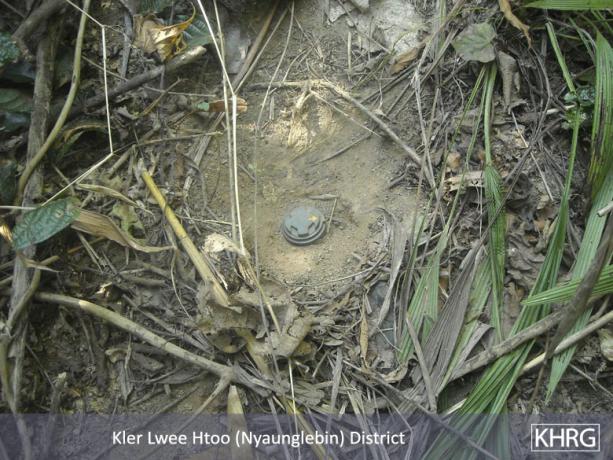At least 2,000 villagers have been displaced by SPDC Army attacks on villages in northern and central Kyauk Kyi Township, Nyaunglebin District. At least four villagers have been killed, while abandoned villages have been burned, including one clinic. More than ten schools have also been abandoned, disrupting students during their exam period. SPDC Army battalions conducted resupply operations at the end of February and KHRG field researchers predict attacks will soon resume.
At least 2,000 people have been displaced since State Peace and Development Council (SPDC) Army battalions from Military Operations Command (MOC)[1] #10 began operating in northern Kyauk Kyi Township, Nyaunglebin District during January 2010[2]. The SPDC has been attempting to consolidate control of this area since beginning an offensive in northern Karen areas in early 2006. This offensive has involved the forced relocation of thousands of villagers to government-controlled lowland areas[3]. Thousands more villagers who seek to evade relocation[4] continue to be subjected to targeted attacks in which they may be shot on sight by SPDC forces and their farms, villages and food stores destroyed.
Homes, clinics and schools have been abandoned as villagers have fled to avoid attacks, which have included the burning and mining of villages. In spite of their best efforts to evade the SPDC Army, for example by use of early warning systems and advance preparation of hiding sites and hidden food stores, five villagers have been shot and killed since January, including one man who returned to his home to retrieve food for his family and a mother and her two children. Battalions from MOC #10 documented in northern Kyauk Kyi Township include Light Infantry Battalion (LIB) #361, #362, #363, #364, #365, #366, #367, #368, #369 and #370[5]. Well to the south, in Shwegyin Township past the road linking Shwegyin Town and the Koh Hshaw SPDC Army camp, LIB #350 from MOC #20 has also begun new operations in the area around Htee Blah, Htee Wah Kee and Doo Pah Leh villages. Soldiers from LIB #350 operating in this area are commanded by Than Sein Ko. This confirms an early report by the Free Burma Rangers (FBR), which estimated that the operation by LIB #350 displaced 200 people[6].
KHRG first documented the displacement of 1,000 villagers in Kyauk Kyi Township on January 17th 2010, when LIB #367 established a camp near Keh Der village tract, between the Theh Loh and Mu Loh rivers. At the time, LIB #367 shot and killed Saw My---, 40, from Keh Der, as well as Saw E---, from Tu Ghaw village[7]. Then, on February 5th 2010, near the edge of Kyauk Kyi Township and to the south of Keh Der, SPDC soldiers entered the Kwee Lah village tract area, displacing another group of villages. Parts of Kwee Lah are close to the Roh Ka So SPDC camp, and until February villagers had been able to evade SPDC Army control while living just a few hours away from an established army camp. As a result of these attacks, KHRG researchers now estimate 2,000 villagers from Kyauk Kyi are newly displaced, in hiding and actively seeking to avoid being shot by the SPDC Army.
Attacks on these villages appear designed to make the area unliveable, driving villagers into government-controlled areas, into ever-shrinking areas where they can evade control or into refugee camps in Thailand. While patrols are enough to cause temporary displacement as villagers flee to avoid being shot, SPDC troops have also been burning and, in some cases, mining villages to make it difficult for villagers to return and resume their lives. On February 7th 2010, for instance, Hih Dtoh Htah and Ka Dee Muh Der villages were razed. Two days later, on February 9th 2010 Htee Baw Htah was burnt as well. After SPDC forces finished burning villages in Keh Der village tract, troops departed the area on February 16th 2010. Villagers that returned along with Karen National Liberation Army (KNLA) soldiers, meanwhile, found eleven landmines in Kheh Der. More mines likely remain and, because they are unmarked, represent a serious risk to villagers attempting to rebuild their homes or recover materials hidden or left behind when they fled.
At least one clinic was also burnt in these attacks, and more than ten schools had to be abandoned. These attacks occurred just as students entered their final exams, disrupting a crucial phase of their education. For some villages, teachers and students have fled in different directions, meaning that children have been unable to take their exams or continue their schooling. An interview with a teacher describing this situation is available separately as Appendix 1. For other villages, however, communities have gone to great lengths to maintain continuity in their children's lives, in spite of obvious difficulties. In these contexts, children have been able to sit their exams at hiding sites, though they are without materials. Burma Matters Now, which also conducted interviews with displaced villagers in the area, quoted a teacher from one of the villages as saying the following: "We left before they got there so the children were not attacked. Some people have been back to the village and said that the blackboard has gone and everything is broken. We are continuing class in the forest now. It is difficult but it's important they continue to study."[8]
KHRG researchers report that, beginning on February 12th 2010, SPDC battalions attacking villages in Kyauk Kyi began moving south and rendezvousing at Thoh Koh Mountain. Troops appear to have been recalled to provide security for the transportation of rations, as KNLA troops are also active in Kyauk Kyi. In March 2010, MOC #10 began transporting rations and supplies from Dtoh Tha Dah to the new camp at Thoh Koh, via SPDC Army camps at Dtoh Tha Dah, Muh Theh, Thaw Ngeh Der, Baw Ka Htah, Yan Myo Aung and Sah Lae. Villagers living in SPDC-controlled lowland areas, meanwhile, have been forced to help support another resupply effort in southern Kyauk Kyi. On February 25th 2010, troops from MOC #10 based in Roh Ka Soe ordered H---, L---, P---, Ma---, B---, M---, Ht---, Bp--- and Ky--- villages to transport rations and equipment using 100 bullock carts belonging to local villagers.
While the resupply operation at Thoh Koh brought a momentary lull in attacks, when KHRG researchers made their report near the end of March, they expected attacks to resume in the near future. Thoh Koh is also just an hour's walk from Muh Lay Kee, Doo Baw Loo, Htee Nyah Dtay Kee and Kheh Der. Villagers from these areas, consequently, remain in hiding and unable to safely return home to retrieve food or other supplies left behind during flight. On March 26th 2010, meanwhile, FBR reported another attack by MOC #10 in Kyauk Kyi. According to FBR, on March 22nd 2010 LIB #369 entered Kaw Hta village and set fire to 11 homes, completely burning 6. Naw Pah Lah, who was passing through Kaw Hta as she returned from visiting her parents in another village, was shot and wounded during the attack. Her 5-year-old daughter and 5-month-old son were both shot and killed. A third victim, Naw La Pwey, age 37, was also shot and killed. "I tried to hold my daughter's hand and pull her but she was already dead so I left her on the trail. First, I thought I will run quickly and warn the Kaw Hta villagers, but because I was hit I could not make it," Naw Pah Lah told FBR. "When I ran, two of the Burma Army soldiers came to me and said 'run run' in Karen language, but I couldn't so I heard more gun shots in the village."[9]
Villagers are currently surviving by sharing food as well as receiving assistance from a small number of organisations based in Thailand that are able to covertly access the area and provide support. Coverage from these organisations is incomplete, however, and some populations remain in need of assistance. Presenting a larger risk over the medium term, however, is the fact that the attacks are preventing farmers from accessing their hillside paddy fields. April is a time when farmers should be burning and clearing their fields, preparing to plant their paddy at the beginning of the rainy season in May. While villagers in many parts of Karen State employ a variety of strategies to cultivate fields while avoiding attack[10], these strategies are not currently sufficient for them to work safely in northern Kyauk Kyi. If farmers are not able to regain safe access to their farms in the next two months, they risk missing a key point in the agricultural cycle. An ill-prepared - or missed - planting period risks a weak or failed harvest, increasing the possibility of food shortages: a devastating prospect for subsistence farmers whose families survive on the products of their labour[11].
Footnotes:
[1]Military Operations Command (MOC) typically consists of ten battalions. Most MOCs have three Tactical Operations Commands (TOCs) of three battalions each. A Light Infantry Division (LID) also consists of ten battalions.
[2]This number is based on estimates by KHRG researchers in the area. The organisation Burma Matters Now, which also conducted research in the area, independently came to a similar conclusion. See, "Internal Displacement Report: February 3 - 7, 2010," Burma Matters Now, February 2010.
[3]For details of these forced relocations, see Cycles of Displacement: Forced relocation and civilian responses in Nyaunglebin District, KHRG, January 2009.
[4]According to the Thai-Burma Border Consortium, at least 54,300 displaced villagers are actively seeking to evade SPDC control in northern Karen areas. See, Protracted Displacement and Militarisation in Eastern Burma, TBBC, October 2009.
[5]This confirms reports by FBR, which reported LIB #361, 362, 366, 367 and 368 from MOC #10 carrying out the attacks in Kyauk Kyi.
[6]See, " Update Of Burma Army Attacks, Murders, Displacement And Forced Labor In Karen State, Burma," FBR, January 2010.
[7]For more details on these events, see " Attacks on displaced villagers in Nyaunglebin District," KHRG, January 2010. For photos of victims killed in the attacks, see " Photos from One of the Areas (Kweh Der, Ler Doh) Attacked by Burma Army," Free Burma Rangers, January 2010.
[8]" My children have never had a home," Democratic Voice of Burma, April 2010.
[9]For more details regarding this attack, including photo documentation, see " Children Shot and Killed by the Burma Army," FBR, March 2010; " Follow-up story: to story of Children Shot and Killed by Burma Army," FBR, March 2010.
[10]For more details on the strategies villagers employ to cultivate fields while avoiding attack by the SPDC Army, see Village Agency: Rural rights and resistance in a militarized Karen State, KHRG, November 2010.
[11]For more details on the way farming is disrupted by SPDC Army attacks as well as the consequences for villagers, see " Starving them out: Food shortages and exploitative abuse in Papun District," KHRG, October 2009. See also, Food crisis: The cumulative impact of abuse in rural Burma, KHRG, April 2009.









